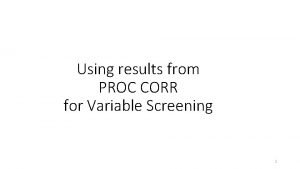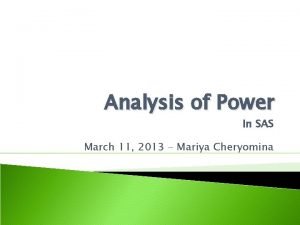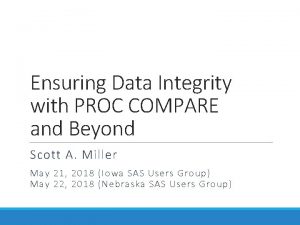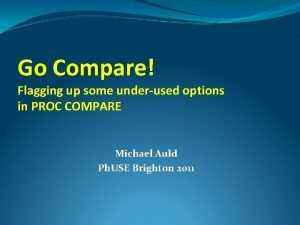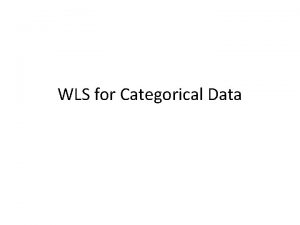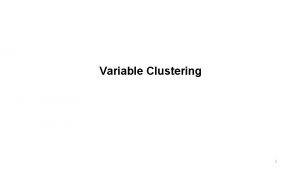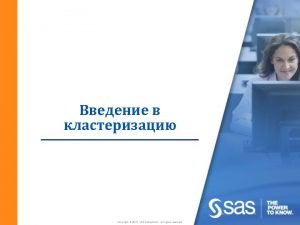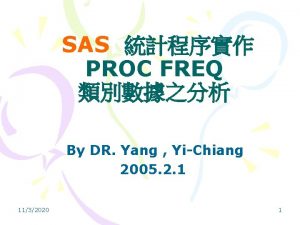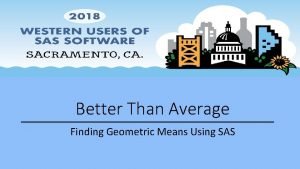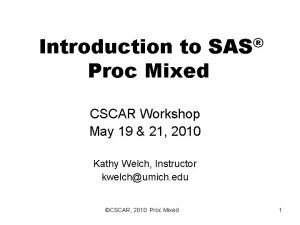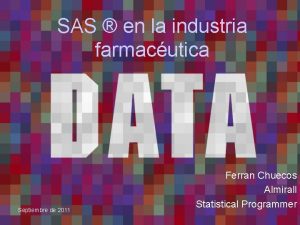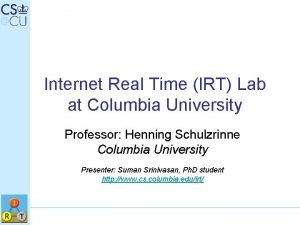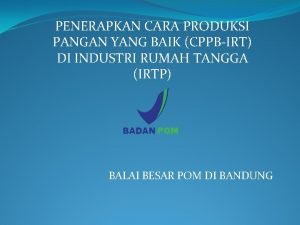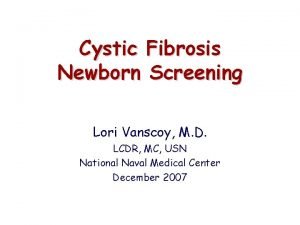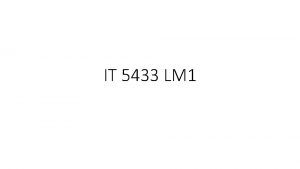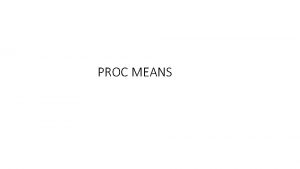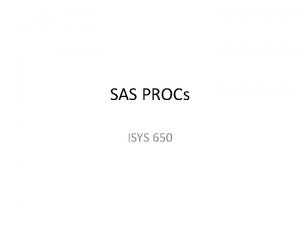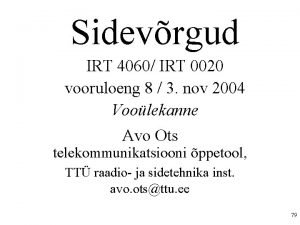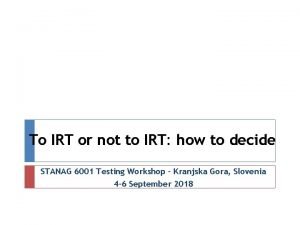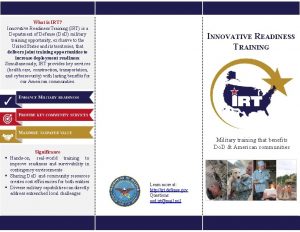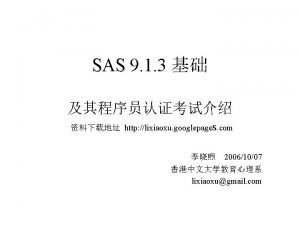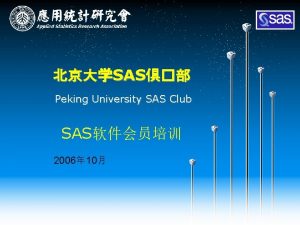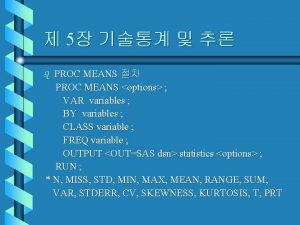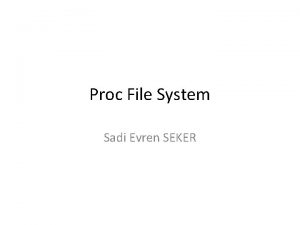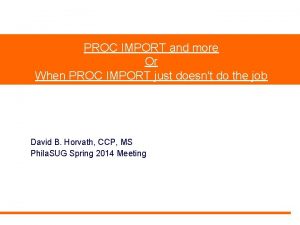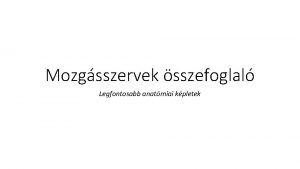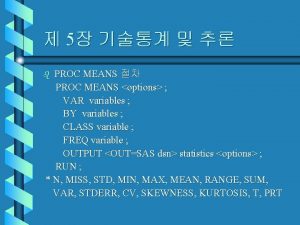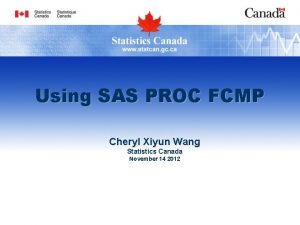SAS PROC IRT July 20 2015 RCMAREXPORT Methods
























- Slides: 24

SAS PROC IRT July 20, 2015 RCMAR/EXPORT Methods Seminar 3 -4 pm http: //chime. med. ucla. edu/seminars/ Acknowledgements: - Karen L. Spritzer - NCI (1 U 2 -CCA 186878 -01) Ron D. Hays, Ph. D. 1

Patient-Reported Outcomes Measurement Information System (PROMIS®) • Reduce response burden. • Improve measurement precision. • Compare or combine results from multiple studies. • Use computer-based administration, scoring, and reporting.

3

The PROMIS Global Health item pool/scale assesses health in general (i. e. overall health). The global health items include global ratings of the five primary PROMIS domains (physical function, fatigue, pain, emotional distress, social health) as well as perceptions of general health that cut across domains. Global items allow respondents to weigh together different aspects of health to arrive at a “bottom-line” indicator of their health. Similar global health items have been found predictive of future health care utilization and mortality. The PROMIS Global Health items include the most widely used single self-rated health item (“In general, would you say your health is. . . ”). Previous research has shown that this item taps physical and mental health about equally but reflects physical health more than mental health among respondents at lower income levels. PROMIS Global Health items include specific ratings of physical health and mental health, as well as a rating of overall quality of life. The remaining items provide global ratings of physical function, fatigue, pain, emotional distress, and social health. The PROMIS Global Health items can be administered as individual items or combined to produce separate physical and mental health summary scores (see Hays, Bjorner, Revicki, Spritzer, & Cella, 2009). 4

PROMIS Global Physical Health (alpha = 0. 81) • In general, how would you rate your physical health? (Global 03) • To what extent are you able to carry out your everyday physical activities such as walking, climbing stairs, carrying groceries, or moving a chair? (Global 06) • How would you rate your pain on average? (Global 07) • How would you rate your fatigue on average? (Global 08)

Graded Response Model § Item “difficulty” and “discrimination” parameters § Probability of item responses modeled as: e D*a (theta – b) ------------ 1+e D*a (theta – b) 1/(e-D*a (theta – b)) e = 2. 718 D = scaling constant, 1. 7 = normal ogive a = discrimination b = difficulty

Global Physical Health Item Parameters Item A B 1 B 2 B 3 B 4 Global 03 2. 31 -2. 11 -0. 89 0. 29 1. 54 Global 06 2. 99 -2. 80 -1. 78 -1. 04 -0. 40 Global 07 1. 74 -3. 87 -1. 81 -0. 67 1. 00 Global 08 1. 90 -3. 24 -1. 88 -0. 36 1. 17 3. In general, how would you rate your physical health? 6. To what extent are you able to carry out your everyday physical activities such as walking, climbing stairs, carrying groceries or moving a chair? 7. How would you rate your pain on average? 8. How would you rate your fatigue on average? 3: 6: 7: 8: Poor; Fair: Good; Very Good: Excellent Not at all, ; A Little; Moderately; Mostly; Completely Worse pain imaginable (10) - No pain (0) Very Severe; Moderate; Mild; None

IRT Software • IRTPRO 2. 1 for Windows – Li Cai, David Thissen & Stephen du Toit – http: //www. ssicentral. com/irt/ – MULTILOG was predecessor • WINSTEPS – http: //www. winsteps. com/index. htm – http: //www. ati-online. com/pdfs/research. K 12/Rasch. Vs. Birnbaum. pdf • STATA 14 – http: //www. stata. com/stata 14/irt/ • SAS Version 9. 4 (TS 1 M 2)

PROC IRT Polychoric correlations between ordinal variables (Underlying normally distributed continuous latent variables) Eigenvalues and scree plots IRT model fit statistics IRT model parameter estimates Item characteristic and information curves Test (scale) information curve An, X. , & Yung, Y-F. (2014). Item response theory: What it is and how you can use the IRT procedure to apply it. Paper SAS 364 -2014. http: //support. sas. com/resources/papers/proceedings 14/SAS 364 -2014. pdf

PROC IRT Code DATA PROMIS; INFILE "C: PCARgh_orig_all. dat"; INPUT CASEID GLOBAL 03 GLOBAL 06 R_GLOBAL 07 R_GLOBAL 08; RUN; *********************; TITLE "PROC IRT EXAMPLE USING PROMIS GLOBAL PHYSICAL HEALTH SCALE"; PROC IRT DATA=PROMIS POLYCHORIC PLOTS=(ALL); VAR GLOBAL 03 GLOBAL 06 R_GLOBAL 07 R_GLOBAL 08; RUN;


PROC IRT Output

13

Poor Very Good Fair Excellent 14

15

Rel = (Info – 1) / Info 16

Some PROC IRT Options • RESFUNC = RASCH • EQUALITY GLOBAL 03 GLOBAL 06 R_GLOBAL 07 R_GLOBAL 08/parm=[slopes]; • LINK = PROBIT – LOGISTIC / 1. 7 – Camilli, G. (1994). Origin of the scaling constant d = 1. 7 in item response theory. Journal of Educational and Behavioral Statistics, 19, 293 -295.

Global Physical Health • Five items – RMSEA = 0. 220 • r = 0. 29 between two items: – In general, how would you rate your health (1) – In general, how would you rate your physical health? (3) – RMSEA = 0. 081 • Dropped general health item (1)

Local Independence Assumption Items a a* Global 03 2. 31 7. 65 Global 06 2. 99 1. 86 Global 07 1. 74 1. 13 Global 08 1. 90 1. 35 Global 03: In general, how would you rate your physical health? * Item discrimination parameters when also including “In general, would you say your health is: ” item.

In general, how would you rate your health? Excellent Very Good Fair Poor 20

21

In general, how would you rate your health? 62 = Excellent 54 = Very Good 47 = Good 38 = Fair 29 = Poor Reliability = 0. 52 (compared to 0. 81 for 4 -item scale). 22

Suggested Readings Hays, R. D. , Bjorner, J. , Revicki, D. A. , Spritzer, K. , & Cella, D. (2009). Development of physical and mental health summary scores from the Patient-Reported Outcomes Measurement Information System (PROMIS) global items. Quality of Life Research, 18, 873 -80. Hays, R. D. , Morales, L. S. , & Reise, S. P. (2000). Item Response Theory and Health Outcomes Measurement in the 21 st Century. Medical Care, 38 (Suppl. ), II-28 -II-42. Hays, R. D. , Spritzer, K. L. , Thompson, W. W. , & Cella, D. (2015 epub). U. S. general population estimate for “excellent” to “poor” self-rated health item. Journal of General Internal Medicine.

Thank you. drhays@g. ucla. edu @Ron. DHays (twitter) Powerpoint file at: http: //gim. med. ucla. edu/Faculty. Pages/Hays/ 24
 Proc corr syntax
Proc corr syntax Sas proc power
Sas proc power Proc compare options
Proc compare options Sas proc compare maxprint
Sas proc compare maxprint Proc catmod sas
Proc catmod sas Proc varclus in sas
Proc varclus in sas Proc traj
Proc traj Sas proc cluster
Sas proc cluster Proc tabulate output
Proc tabulate output Proc freq sas
Proc freq sas Sas maps online
Sas maps online Geometric coefficient of variation
Geometric coefficient of variation Sas proc iml
Sas proc iml Proc mixed syntax
Proc mixed syntax Proc transpose sas ejemplos
Proc transpose sas ejemplos Irt lab
Irt lab Cppb-irt
Cppb-irt Irt software
Irt software Cystic fibrosis irt
Cystic fibrosis irt Drexel irt
Drexel irt Irt 5433
Irt 5433 Amd 700 series
Amd 700 series Indirect wax pattern
Indirect wax pattern July 1-4 1863
July 1-4 1863 March april june july august
March april june july august
